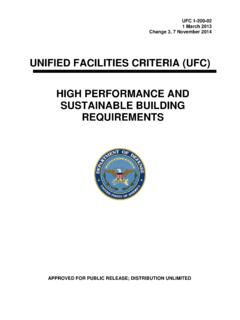Transcription of DoD Logistics Human Capital Strategy - Under Secretary of ...
1 DoD Logistics Human Capital Strategy Office of the Secretary of Defense Sustainment June 21, 2019. In the 2017 National Security Strategy , the President directed that the Joint Force remain capable of deterring and defeating a full range of threats to the United States. The Department of Defense (DoD) must be prepared to defend the homeland, remain the preeminent military power in the world, ensure the balances of power remain in our favor, and advance an international order conducive to the nation's security and prosperity. To meet this call to action, the Department is investing broadly in the deployment of autonomous vehicles, artificial intelligence, machine learning, and the rapid application of commercial breakthroughs to gain a competitive advantage.
2 With this new technology comes new operational concepts and capabilities and the need for resilient and agile Logistics support. Logistics by its very nature is a Human endeavor. As the DoD introduces more advanced weapons systems and enterprise resource planning tools to bolster supply chain and distribution systems, the guild concept we've used since the 1950s to grow logisticians and maintainers will have to become more adaptive to address global threats and continuously changing technologies. A MESSAGE FROM THE The DoD Logistics Human Capital Strategy we're introducing with this document addresses the President's concerns as codified in the National DEPUTY ASSISTANT Security Strategy . It supports the Secretary of Defense in ensuring our military Secretary OF DEFENSE remains the preeminent fighting force.
3 It advances the joint Logistics FOR PRODUCT SUPPORT enterprise by introducing Human Capital tools to complement our current workforce and ensures a modern, agile, information-advantaged workforce for the future, as new technologies are introduced into the DoD weapon system inventory. Gary J. o,tsek Deputy Afsistant Secretary of Defense for Product Support r. Building Adaptive Logistics Professionals that Empower the Modern Warfighter i'. Table of Contents A MESSAGE FROM THE DEPUTY ASSISTANT Secretary OF DEFENSE FOR PRODUCT 2. Mission and 4. Mission .. 4. Vision .. 4. Introduction .. 5. Scope .. 5. FY 2018 FY 2026 Logistics Workforce Strategic Goals .. 6. Structure of the Logistics Human Capital Strategy .. 6. Section 1. Background.
4 6. DoD Logistics Human Capital Strategy .. 6. 2008 Human Capital Action Plan Accomplishments .. 8. Current Environment and Challenges .. 9. Strategic Goal 1: Develop and Manage the Talent .. 11. Strategic Goal 2: Enhance Logistics Human Capital -Related Processes and Tools .. 13. Strategic Goal 3: Well Informed Civilian Logistics Workforce .. 14. Section 2. State of the Workforce .. 15. Services, Components and 4th Estate .. 15. Logistics Workforce by Career 16. Logistics Workforce Categories .. 17. Logistics Workforce Gains and Losses .. 17. Logistics Workforce by Education 18. Age and Demographics .. 18. Retirement Eligible Distribution .. 18. Section 4. Summary .. 19. Appendix 1. References and Further Information .. 20.
5 Appendix 2. Human Capital Fact Sheet .. 21. Building Adaptive Logistics Professionals that Empower the Modern Warfighter 3. Mission and Vision Mission Support the Department of Defense (DoD) with a professional, flexible, highly-skilled Human Capital Logistics workforce that possesses the knowledge, skills and abilities needed to ensure readiness for winning the war across the spectrum of military operations. Design, implement, and sustain a world-class employee professional development program to facilitate a highly trained and well-educated workforce empowered to continually learn and thrive in a rapidly changing environment. Vision A Logistics enterprise cultivated and institutionalized by DoD Logistics Human Capital planners that is ready to support any combination of combat, security, engagement, acquisition, sustainment, and relief and reconstruction operations.
6 The employee development program will include a broadly-based, highly integrated combination of practitioner training, continuing education, career development, professional certification, proficiency documentation, competency-based evaluations, mentoring, employee recognition, career broadening, leadership development, and easily quantifiable workforce readiness metrics for assessing and rewarding successful performance. Building Adaptive Logistics Professionals that Empower the Modern Warfighter 4. Introduction Scope This Human Capital Strategy covers approximately 156,000 civilian Logistics professionals across the Department, including the Military Departments and Defense Agencies. The Logistics workforce is the largest functional community (group of occupational series with common functions, competencies, and career paths) within DoD, currently spanning 126 Logistics occupational series, operating globally to provide precision support to United States Soldiers, Sailors, Airmen, and Marines.
7 The Logistics community landscape consists of four Logistics workforce categories: life cycle Logistics (LCL), supply management, maintenance support, and deployment/distribution/transportation and includes both salaried and wage-grade logisticians (Figure 1). This Strategy outlines goals and objectives to sustain and improve the capacity and capabilities of the DoD Logistics workforce. Its goals are aligned and support overarching DoD strategic direction outlined in the 2018 National Defense Strategy and the National Military Strategy . Figure 1: The 2018 Logistics Landscape *Note: Dotted line in each lane represents the Salaried/Wage Grade composition of that portion of the workforce. Salaried is below the line, and wage grade is above the line.
8 This picture is a representation of the complexity of the DoD Logistics workforce. The blue boxes, when all taken together, represent the ~156,000 civilians in the 126 occupational series assigned to the Logistics Functional Community (LFC). Each of the blue boxes represents one of the four Logistics workforce categories life cycle Logistics , supply management, maintenance support, and deployment/distribution/transportation. The white dotted line within each lane represents the Salaried/Wage Grade composition of that portion of the workforce (Life Cycle Logistician (LCL) has only 1 Wage Grade employee). Salaried is below the line; wage grade is above the line. The green box augments the darkest blue box and represents the personnel who have been coded as a LCL in the Defense Acquisition Workforce but are either military or not in an occupational series that belongs to the LFC.
9 The red box exists entirely within the darkest blue box and represents those personnel that have been assigned to Key Leadership Positions as a Product Support Manager. Building Adaptive Logistics Professionals that Empower the Modern Warfighter 5. The orange box represents personnel who are performing Logistics work but are in occupational series not assigned to the LFC and are not part of the LCL Acquisition workforce. These personnel may be supporting supply, maintenance, or deployment/distribution/transportation efforts. The yellow box represents the military personnel working in Logistics as estimated at this time. FY 2018 FY 2026 Logistics Workforce Strategic Goals In order to effectively support the efforts of Warfighters worldwide, the DoD must recruit, retain, and professionally develop a Logistics workforce that is integrated, agile, innovative, and high-performing.
10 In response to that requirement, it is essential that the Department pursue the following strategic goals. Structure of the Logistics Human Capital Strategy Background: Provides an overview of the 2008 DoD Logistics Human Capital Strategy (HCS), and accomplishments and concludes with a look at the current environment and challenges. Innovation, Emerging Technology and Key Enablers: Outlines the Logistics Workforce Strategic Goals and supporting initiatives. State of the Workforce: Provides an analysis of the current Logistics workforce and the apparent trends shaping the future force. Summary. Appendices. Section 1. Background DoD Logistics Human Capital Strategy The DoD Logistics workforce exists to enable the military force to fight and win wars through its continuity, unique skills, competencies and dedicated commitment to the mission.










![Equipment [Section 285A TCA 1997] Accelerated Capital ...](/cache/preview/5/d/6/a/5/3/a/d/thumb-5d6a53ad8b4554d5690f045ebdcb0fe7.jpg)



